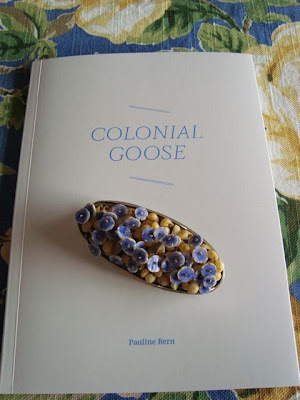Botanicals 6
In this, the last of my botanically themed posts, I want to tell you about a newly published catalogue documenting Pauline Bern's latest body of botanical jewellery, Colonial Goose. The catalogue was launched on Sunday at a small gathering in Pauline's beautiful Devonport garden where we drank chilled gin and tonics with mint and lime and snacked on canapes under the shade of the almond tree. Very genteel!
The catalogue was designed by award winning designer, Alan Deare of Area Design, the jewellery was beautifully photographed by Haruhiko Sameshima, and I was the lucky one invited to write the text, for which I received the magnificent brooch (posed above sitting on the catalogue).
Here's a little sampling from the text to give you an idea of what the jewellery is about:
Colonial Goose, the collective title for the body of jewellery produced by Pauline Bern over the past year, refers to a recipe from the colonial era and harks back to the early pioneering tradition in New Zealand of making do with what’s on hand. In this case, owing to a scarcity of geese, the traditional English Christmas fare of roast goose was substituted for a stuffed leg of lamb or mutton, prepared in such a way that the completed dish resembled a goose, even though it wasn't.
The colonial and wartime necessity of making do with what’s available is a fitting analogy for Bern’s jewellery practice, which always involves using locally sourced materials that are both on hand and connected to the jeweller’s life in some way, and transforming them into something new. Vintage New Zealand postage stamps belonging to Bern’s grandmother were used in a recent body of work; the shells in earlier works were sourced from her local beach; and a selection of plants from her Devonport garden have provided the primary material for the pieces in Colonial Goose.
[...]
It is, however, the more fickle aspect of Colonial Goose – the one thing masquerading as another that forms the major theme of this new body of work.
[...]
The works in Colonial Goose are once again situated squarely in Bern’s quarter-acre section and her method might best be described as the misadventures of a backyard naturalist. The jewellery in Colonial Goose results from the Frankensteinian process of grafting together particular pieces from different plants, along with shells, metals, and other inorganic materials, to create new ‘botanical’ species that could never, in actuality, exist.
Here are a few images from the catalogue:
What I love most about Pauline Bern's Colonial Goose is the way that beneath the pretty surface of the pieces something more sinister is lurking. Look more closely at the cluster of lilac coloured flowers in my brooch, for instance, and you'll see thorns from the Mutabilis rose nestled menacingly within the oval setting.
The hidden thorns within the composition of this brooch, as well as a number of others in the series, reveal the darker subtext of the piece – the sweetness of the flowers and the sharpness of the thorns that operate as a larger metaphor for the garden itself, where danger and beauty coexist and binary opposites collide: soft / sharp, hidden / revealed, recognisable / deceptive, native / exotic.
I do need to remember not to hug people too closely when I'm wearing this brooch though. I inadvertently stabbed my friend Karl in the chest when he arrived at the garden party on Sunday! Ouch!











Comments